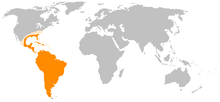Polites vibex
| Whirlabout | |
|---|---|
| Male P. v. praeceps, Tobago | |
Not evaluated (IUCN 3.1) | |
| Scientific classification | |
| Kingdom: | Animalia |
| Phylum: | Arthropoda |
| Class: | Insecta |
| Order: | Lepidoptera |
| Family: | Hesperiidae |
| Tribe: | Hesperiini |
| Genus: | Polites |
| Species: | P. vibex |
| Binomial name | |
| Polites vibex (Geyer, [1832]) | |
| Subspecies | |
| |
 | |
| Year round Migration | |
| Synonyms | |
| |
Polites vibex, or the whirlabout,[1] is a grass skipper in the Hesperiidae family. The whirlabout gets its name from the landing and take off flight patterns of the adult – a circular or vortex or whirling motion.[2] It is resident from the southeastern U.S. and West Indies to eastern Mexico through the tropics down to Argentina.[3] During the summer it can sometimes be found as far north as Ohio, Connecticut, and northeast Iowa.[3] The wingspan is 25–38 mm (0.98–1.50 in).[4] It flies all year in the extreme south and migrates north in late summer and fall.[4]
The larvae feed on grasses mainly at night.[1][4][5] Eggs are white and laid one at a time on the host plants.[6]
Description
The whirlabout exhibits sexual dimorphism.[5] Although the two sexes are about the same size with a wingspan of 25–38 mm (0.98–1.50 in), they vary greatly in coloring and pattern. Both have elongated wings but male is orange and yellow and the female is dark brown.[6]
Male
From above, the forewing is orange with a black stigma and nearby scales that form a dark, four-sided patch. The forewing also has a jagged black border. The hindwing has a black margin that is smooth inwardly.[3]
From below, the hindwing is golden orange with large, dark, smudged spots.[5]
Female
From above, the forewing is dark brown with light colored spots.[6] From below, the hindwing is a greyish yellow-brown with a couple of bands of large brown spots and light central patch with dark scales at edges.[3]
_male_dorsal.jpg) Male
Male_male_dorsal_(1).jpg) Male
Male Male
Male_female_ventral.jpg) Female
Female_mating.jpg) P. v. praeceps mating in Tobago
P. v. praeceps mating in Tobago
Geographic Range
The whirlabout butterfly is resident from the southeastern U.S. and West Indies to eastern Mexico through the tropics down to Argentina.[3] During the summer it can sometimes be found as far north as Ohio, Connecticut, and northeast Iowa.[3]
Habitat
Coastal plain grassy areas,[5] fields, dunes, pinewoods, roadsides,[3] disturbed areas, vacant lots, open woodlots, forest edges, parks, lawns, and gardens.[6]
Food resources
Caterpillars
Grasses.[5]
Adults
Nectar of flowers.[6]
References
- 1 2 Polites, funet.fi
- ↑ Brock, Jim P.; Kaufman, Kenn (2003). Kaufman Focus Guides Butterflies of North America. New York: Houghton Mifflin Company. p. 302. ISBN 0618254005.
- 1 2 3 4 5 6 7 Opler, Paul A.; Vichai Malikul (1998). A Field Guide to Eastern Butterflies (Peterson Field Guides). Houghton Mifflin Company. p. 377. ISBN 978-0-395-90453-4.
- 1 2 3 Whirlabout, Butterflies of Canada
- 1 2 3 4 5 Scott, James A. (1986). The Butterflies of North America A Natural History and Field Guide. Stanford University Press. p. 446. ISBN 0-8047-2013-4.
- 1 2 3 4 5 Daniels, Jaret C. (2003). Butterflies of Florida Field Guide. Adventure Publications, Inc. pp. 178–179. ISBN 978-1-59193-005-1.
External links
- Whirlabout, Butterflies and Moths of North America